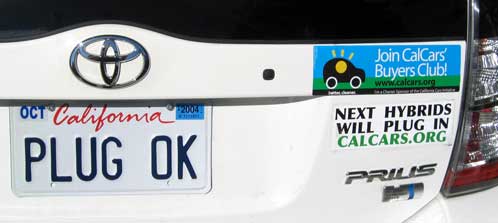| |
 |
 |
||
|
 FOR DECISIONMAKERS AT COMPANIES AND ORGANIZATIONS The California Cars Initiative has been asked to provide estimates of the cost of converting a mini-fleet of 2004 Priuses to become plug-in hybrids (PHEVs).The interest is inspired in part by the $4M+ plan announced by the South Coast Air Quality Management District to convert 30-35 Priuses to run as hydrogen-electric hybrids (for more on the SCAQMD plan, see links at the end of How the '04 Prius Can Become a PRIUS+ Plug-In Hybrid). We are highly encouraged that others also see the elegant and efficient Prius as the starting point for future generations of much-improved cars. We are building support for a "side-by-side" alternative to these hydrogen internal combustion engine (ICE) cars. We recognize that the SCAQMD plan was developed as part of the development of infrastructure for a future "hydrogen highway" to serve future fuel-cell vehicles, and that long-term considerations may take precedence over calculations of immediate benefits. However, if one were to make a comparison, delivering the hydrogen Priuses will take longer, and will result in lower ICE range, more well-to-wheel emissions and a far higher per-vehicle purchase cost. Converting Priuses to what we describe as "neighborhood-speed PHEVs" can be done within six months of funding. It can provide the capability for an extended range electric-only zero-emissions mode at speeds up to approximately 35 miles/hour, while retaining its existing capabilities to operate at highway speeds as a gasoline-electric hybrid. The steps for PRIUS+ are: A number of CalCars' key advisors, most notably Prof. Andy Frank of the University of California at Davis (who has built over a dozen PHEVs), have confirmed that such an effort is feasible and will result in significantly improved performance and reduced emissions. We conservatively estimate the plug-in range of the resulting vehicle at 5-15 miles. The real number will depend almost entirely on the characteristics of the battery pack (which have not yet been specified), which in turn depends on whether we use off-the-shelf components or are able to involve a battery maker in the project. The benefit: a substantial portion of the miles driven by PRIUS+ cars will no longer be fueled by gasoline. We expect that the range would be considerably higher were Toyota to be involved in the project, but we are not in a position to provide that. (Nor can we provide any assurances that Toyota would allow such changes without voiding the vehicles' warranties.) Over the six months duration of the project, we estimate the cost at $600K to purchase 30 vehicles plus $600K for batteries, administration and engineering. The resulting cost works out to $40K per vehicle, compared to well over $100K for the hydrogen project. It will of course not depend on additional commitments or expenditures to develop a fueling infrastructure. And as is true with any Prius fleet project, it will depend on the availability of cars to convert. If we are in a position to catalyze this project, CalCars plans to work to gain support from a range of partners among the many entities, nonprofit groups and companies that are in a position to support this effort. And we will partner with one or more engineering integration firms to ensure that the project has access to the best experts and many talented individuals who have been working in this area. We emphasize that our goal in pursuing this opportunity is to demonstrate the value of such vehicles to both the public and government agencies, and ultimately to persuade Toyota and other OEMs that there is a market for PHEVs. We know that automakers can build better production vehicles than our prototypes, lowering the cost to an increment only several thousand dollars over the retail price of a non-plug-in hybrid. And forthcoming hybrids (notably the Ford Escape, Lexus RX and Toyota Highlander, all announced for 2004) could be modified to become PHEVs with 20-60 miles of electric range at highway speeds. In that context, we hope our efforts, together with the current commitment by DaimlerChrysler, in partnership with EPRI and several utilities, to build prototype PHEVs on its commercial van Sprinter platform, will speed the availability of PHEVs to the global passenger vehicle market. (For information on these and other efforts see Vehicles.) We continue to evolve this strategy and the accompanying time and cost estimates. Please feel free to share this information with others who may be interested in the concept, and encourage them to contact us. We hope the result will be a coordinated effort to make this plan a reality. If you can connect us with decisionmakers interested in a PRIUS+ mini-fleet (not limited to Californians), contact us: priusplus@calcars.org PRIUS+ Launch Announcement | PRIUS+ Details
© 2004, California Cars Initiative. Last updated Site Map |
 |
||||||||||